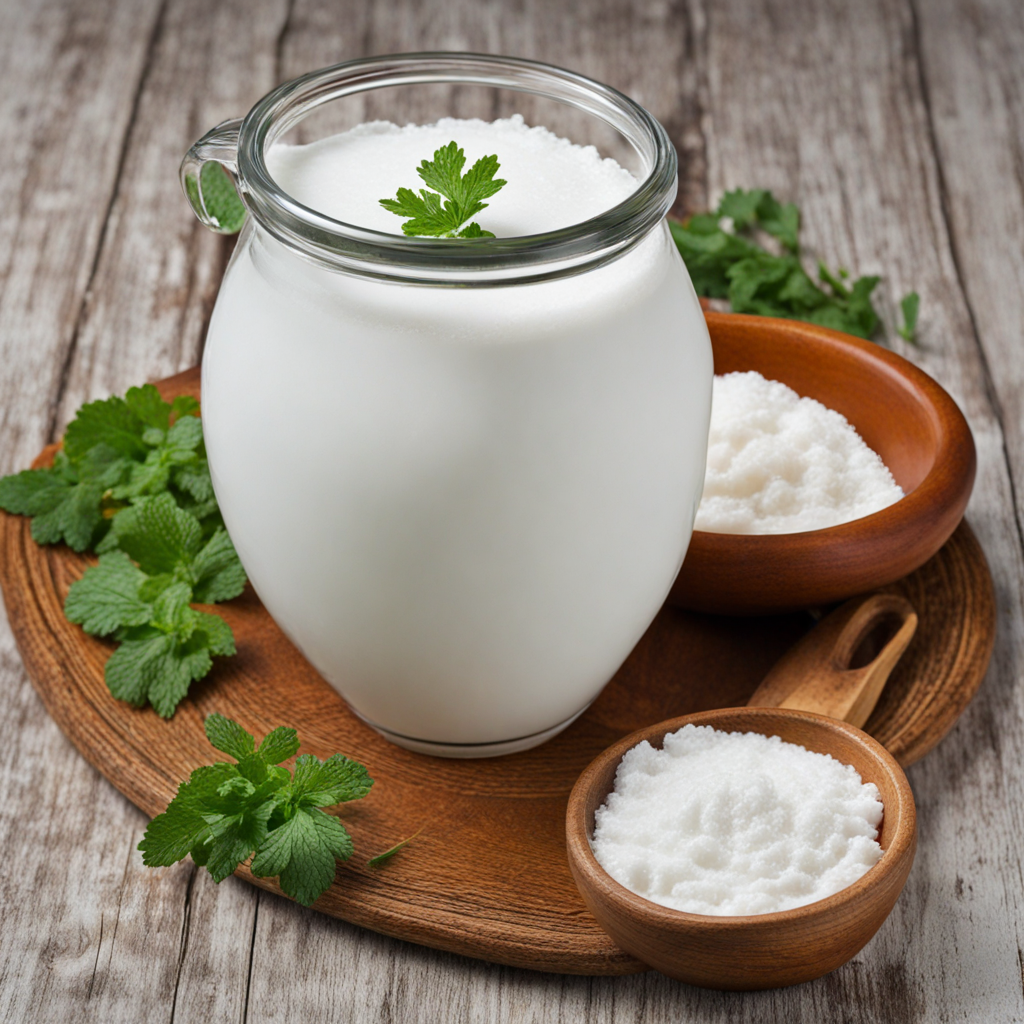Ayran
Айран, pronounced "ayran," is a traditional drink that hails from Central Asia, particularly popular in Kazakhstan, where it has become an integral part of the culinary landscape. This refreshing beverage has its roots in the nomadic lifestyle of the region, where herders relied on milk from their livestock. Historically, айран has been a staple for Kazakh people, providing hydration and nourishment during the long, arduous journeys across the steppes. The flavor profile of айран is distinctively tangy and slightly salty, offering a delightful balance that refreshes the palate. The drink has a creamy texture, making it both soothing and invigorating at the same time. The tanginess comes from the fermentation process, which also contributes to its probiotic qualities, making it beneficial for digestion. Many people enjoy айран as a cooling accompaniment to spicy dishes, as it helps to temper heat and cleanse the palate. Preparation of айран is relatively simple, yet it requires attention to detail to achieve the right consistency and flavor. The primary ingredient is yogurt, which is typically made from cow's or sheep's milk. The yogurt is thinned with water, and sometimes a pinch of salt is added for flavor. The mixture is then whisked or blended until smooth, creating a uniform, drinkable consistency. In some traditional recipes, a bit of fresh herbs, such as dill or mint, may be incorporated to enhance the flavor. The drink can be served chilled, making it an ideal refreshment during the hot
How It Became This Dish
Origins of Айран Айран, a traditional fermented dairy drink, has deep roots in the culinary landscape of Central Asia, particularly Kazakhstan. Its origins can be traced back to the nomadic tribes of the region, who relied heavily on dairy products as a primary source of nutrition. The drink is made by diluting yogurt with water and often adding a pinch of salt. This simple yet effective method not only preserved milk but also provided hydration and essential nutrients, making it a staple for the nomadic herders who traversed the vast steppes of Kazakhstan. The process of making айран dates back centuries, with its earliest mentions found in ancient texts and folklore. The drink is believed to have been consumed by the Turkic tribes, who understood the importance of fermented products in their diet. The fermentation process not only extended the shelf life of milk but also enhanced its nutritional profile, making it a vital component for those who led a mobile lifestyle. Over time, айран became more than just a sustenance drink; it evolved into a cultural symbol, representing hospitality and community among the Kazakh people. Cultural Significance In Kazakh culture, айран holds a special place, often served during gatherings, celebrations, and family events. Its preparation is considered an art form, reflecting the host's hospitality and culinary skills. Guests are typically greeted with айран, signifying respect and welcome. The drink is frequently paired with traditional dishes such as бешбармақ (boiled meat served with noodles) or нан (bread), complementing the flavors and enhancing the overall dining experience. Moreover, айран is often associated with the traditions of the Kazakh people, particularly during the summer months. As nomads moved with their herds, they relied on айран to quench their thirst in the arid climate of the steppes. It became a source of rejuvenation, especially after a long day of herding. In this way, айран symbolizes the connection to the land and the nomadic lifestyle that has shaped Kazakh identity for generations. Health Benefits and Nutritional Value The health benefits of айран are significant, and its consumption is deeply ingrained in the wellness practices of the Kazakh people. Rich in probiotics, it promotes digestive health and boosts the immune system. The fermentation process used to make айран produces beneficial bacteria that aid in digestion, making it easier for the body to absorb nutrients. Additionally, айран is low in calories and high in protein, making it a popular choice for those seeking a healthy beverage option. Beyond its nutritional benefits, айран has been recognized for its hydrating properties, particularly in a region where water can be scarce. The combination of yogurt and water not only replenishes fluids but also provides electrolytes, making it an ideal drink for those engaged in physical labor or outdoor activities. Its refreshing taste and creamy texture make it a favorite among people of all ages, contributing to its longevity in the Kazakh diet. Modern Adaptations As Kazakhstan has evolved, so too has айран. In recent years, the drink has seen a resurgence in popularity, not only within Kazakhstan but also in neighboring countries and beyond. Modern variations of айран can be found in many forms, including flavored versions with fruits or herbs, catering to younger generations and changing tastes. This adaptability has allowed айран to remain relevant in contemporary cuisine while still honoring its traditional roots. In urban areas, айран is now widely accessible in supermarkets and cafes, often marketed as a health drink due to its probiotic content. This commercialization has led to a renewed interest in traditional Kazakh foods, encouraging younger generations to embrace their culinary heritage. The drink is also finding its way into international cuisines, as global food trends lean toward fermented products, highlighting the importance of ayран in a modern context. Regional Variations While айран is a quintessential Kazakh drink, it also has regional variations across Central Asia. In neighboring countries like Kyrgyzstan and Uzbekistan, similar fermented dairy drinks exist, each with slight differences in preparation and flavor. For instance, in Kyrgyzstan, a similar beverage called "kefir" is popular, known for its distinct tanginess and thickness. These variations reflect the shared cultural heritage of the Turkic peoples and the adaptability of traditional foods to local tastes and ingredients. Despite these regional differences, the core principles of making айран remain consistent: the use of high-quality yogurt, water, and sometimes salt. The emphasis on natural ingredients underscores the importance of freshness and authenticity in traditional Kazakh cuisine. This shared practice fosters a sense of unity among the Central Asian nations, as they celebrate their rich culinary traditions while embracing modern influences. Conclusion The history of айран is a testament to the resilience and resourcefulness of the Kazakh people. From its humble beginnings as a practical solution for hydration and nutrition in a nomadic lifestyle to its status as a beloved cultural symbol, айран continues to thrive in the hearts and homes of many. Its health benefits and versatility have ensured its place in both traditional and modern diets, making it a cherished beverage that connects the past with the present. As Kazakhstan continues to develop its identity in a globalized world, айран serves as a reminder of the importance of tradition and the ways in which food can foster community, health, and cultural pride. The drink stands not only as a refreshing beverage but also as a symbol of Kazakhstan's rich heritage, bridging generations and celebrating the unique flavors of the steppes.
You may like
Discover local flavors from Kazakhstan







